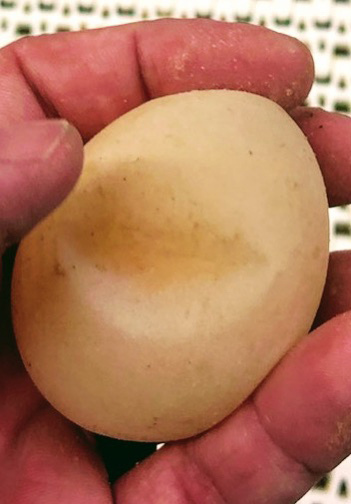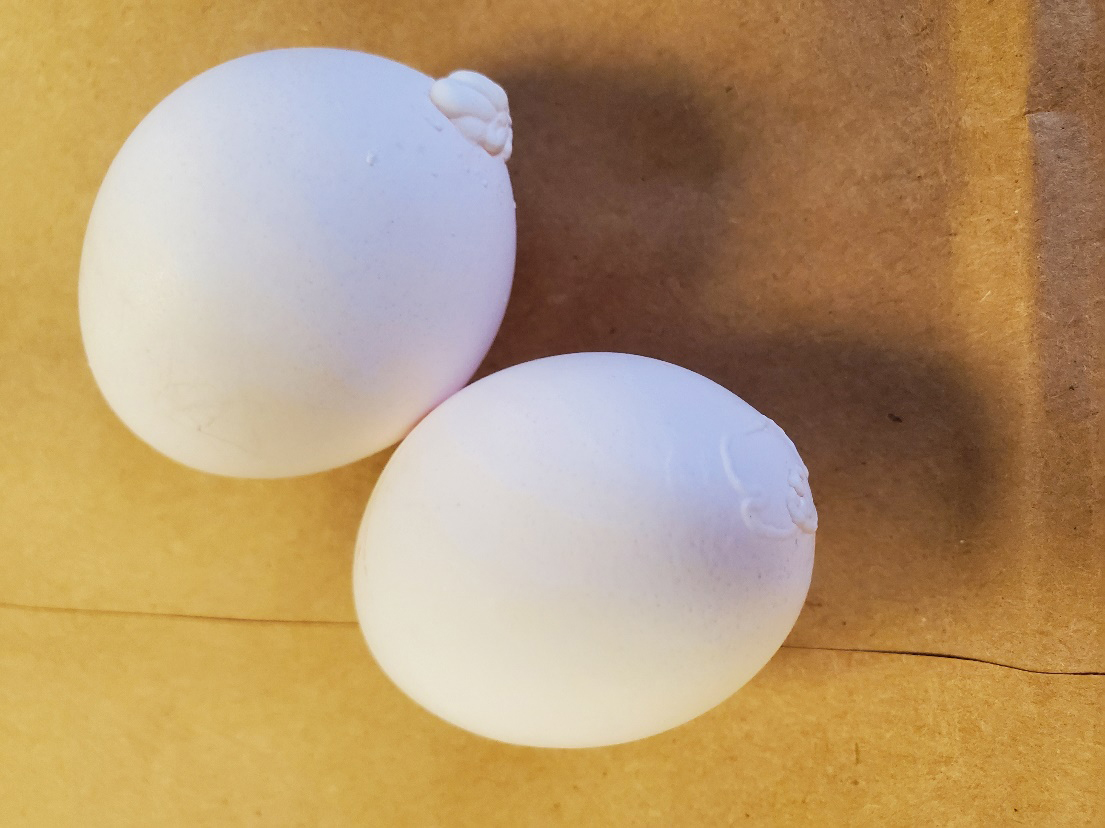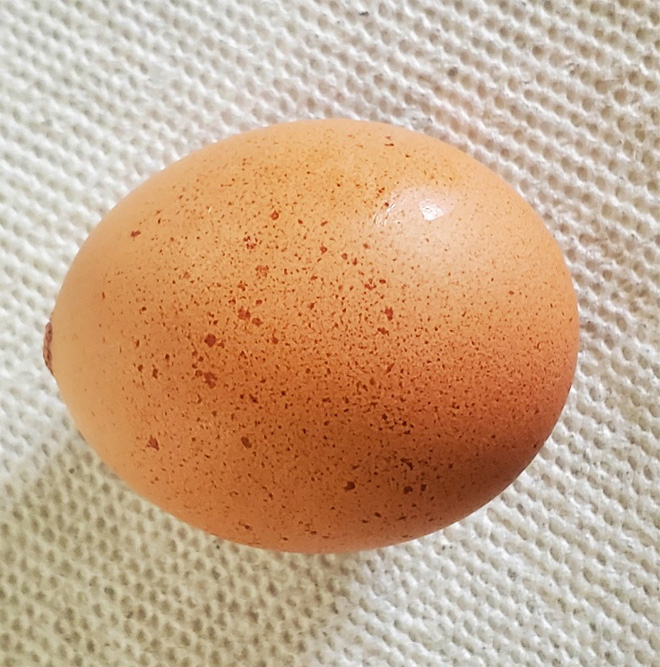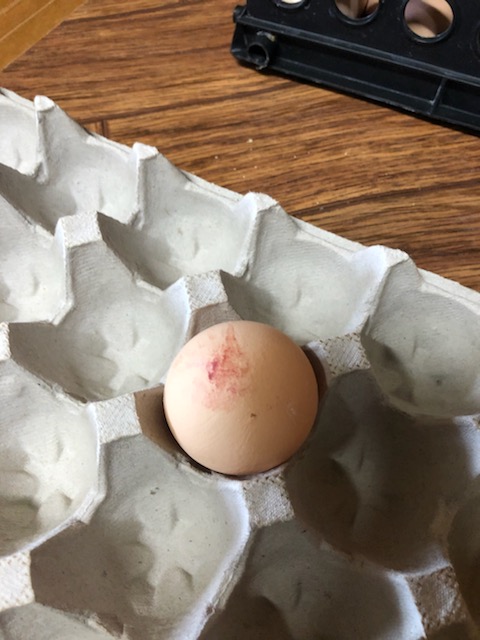Domestic egg production, whether on a large scale or in small and backyard flocks, will often result in some odd–looking eggs. This publication discusses 12 of the more common oddities seen in poultry egg production and explains why the abnormalities occur. Some of these deviations from normal–looking eggs impact egg quality and result in eggs that should be discarded. It takes a chicken approximately 24–26 hr to complete the egg laying process, from the release of the yolk from the ovary to the actual laying of the egg. At the end of the process, a perfectly oval–shaped egg is expected but this is not always what the hen lays.
Shell–less Eggs
A shell–less egg, as the name implies, does not have a shell. Instead, the interior contents of the egg (i.e., yolk and albumin) are protected only by the shell membranes. There are numerous reasons why this may occur. The shell gland is the section of a hen’s reproductive tract where the shell is deposited onto the exterior of the shell membrane. If the shell gland is immature, there’s a greater chance that shell–less eggs may occur. Diseases such as avian influenza, Newcastle disease, infectious bronchitis, and egg drop syndrome ’76 can cause flocks to lay shell–less eggs and it also may happen if the bird's diet is deficient in calcium, phosphorus, manganese, or vitamin D3. A shell–less egg cannot be processed or packaged because it lacks the rigidity and shape of a well–formed eggshell.

Soft–Shelled Eggs

Soft–shelled eggs are different from shell–less eggs. A soft–shelled egg has a thin layer of calcium deposited onto the shell membrane and the egg has a paper–like feel. If a soft–shelled egg is held, it caves to the touch. Soft–shelled eggs are more likely to be observed in older hens. Other potential causes of soft–shelled eggs include too much phosphorus in the diet, moldy feed, salty water, or feed contaminated with mycotoxins. A soft–shelled egg cannot be processed because of its poor eggshell quality.
Calcium Deposits on Eggs
Irregularly shaped excess calcium deposits sometimes can be seen on the surface of an egg’s shell. This can occur if the shell gland is defective or if there are disturbances during the calcification process during egg formation and deposits can be observed on eggs of any color. Too much calcium and/or vitamin D in the diet also can cause calcium deposits on eggs. The size of the calcium deposit determines whether excess calcium affects eggshell quality. Based on United States Department of Agriculture (USDA) standards for grading eggs, an egg with a calcium deposit that is smaller than 1/8 in. can be categorized as a Grade A egg. Any calcium deposit larger than 1/8 in. would downgrade the egg to Grade B.


White or Brown Speckled Eggs
While some breeds lay speckled eggs, the speckled eggs described here are abnormal. Abnormally speckled eggs have smaller speckles than are observed with excess calcium deposits, although these spots also are formed by small calcium deposits. These deposits are laid down before the formation of the cuticle, which is the last layer of the egg. This process occurs in the shell gland. Speckled eggs can happen if the shell gland is defective or if there are disturbances in the chicken house during the calcification process of egg formation. Too much calcium in a hen’s diet also can result in speckled eggs. These eggs are still salable and speckling does not negatively affect the quality of the egg.


Pimpled Eggs
Pimpled eggs have small, raised lumps of calcium on the shell and feel rough and sandpaper–like to the touch. The severity of the pimples depends on the amount of foreign material present during calcification. As with calcium deposits, these eggs would still be Grade A eggs in exterior quality if each pimple is smaller than 1/8 in. Any one pimple larger than 1/8 in. would make that egg a Grade B egg.


Slab–sided Eggs
A slab–sided egg occurs when a second egg enters the shell gland before the first egg leaves. Because the second egg is not yet completely calcified, the side that touches the first egg is flattened. This can occur if there are changes in the chicken house lighting or if the bird is stressed. Diseases also can cause this anomaly. This abnormality has a negative impact on overall egg shell quality because of the thinness of the slabbed area.


Cracked Eggs
These eggs have large cracks, star cracks or hairline cracks that sometimes result in holes in the shell; these holes can allow the contents of the egg to leak. This is more likely to be observed in older hens. It also can occur in younger flocks if the water is salty or if there is a calcium or vitamin D deficiency. Mycotoxins (especially zearalenone) in the diet or heat stress also can cause cracked eggs. Eggs with cracks or thin spots are compromised and this reduces the quality of the egg. Eggs with broken or cracked shells are considered a loss and should not be sold to consumers.


Wrinkled Eggs
These eggs appear to have ridges or wrinkled surfaces. Overcrowding, which results in stressed hens, can cause this abnormality. It also can be seen when a hen’s shell gland is defective or if the flock has infectious bronchitis. Wrinkles can result in weakened shells. Based on USDA standards for exterior eggshell quality, a wrinkled egg is downgraded to Grade B.

Corrugated Eggs
These eggs have a very rough, corrugated-looking surface. This happens during plumping, the process where nutrient rich fluids are pumped into membrane–covered eggs before the shell is laid over the shell membrane. When plumping is not controlled properly and terminates before the process is completed, corrugated eggs result. This abnormality is more common in older hens but can be seen in younger birds. Heat stress, salty water, poor nutrition, and mycotoxin contaminated diets all can cause corrugated eggs. Depending on the severity of the roughness in these eggs, they may be downgraded to Grade B because of eggshell quality.


Mottled Eggs
Mottled eggs have a spotty appearance to the naked eye. The spots, which are more translucent than the other areas of the shell, can be seen clearly when candled. This condition occurs when the shell fails to dry out quickly. It is common in overcrowded houses with high humidity. Manganese deficiency, disease and mycotoxins also can cause mottled eggs. This condition of the egg does not alter the grade for exterior shell quality.


Dirty Eggs
Every egg producer knows that eggs can get dirty if they are not collected from the nests in a timely manner. However, eggs can be stained with excreta when the flock has wet, pasty droppings. Large amounts of indigestible compounds in their feed, poor gut health, or salty water can cause wet droppings, as can ingredients such as cassava (yucca or tapioca), wheat, barley, or rye. Based on USDA standards for exterior eggshell quality, any egg with slight to moderate stains can be classified as Grade B or dirty depending on the size and number of stains. The eggs pictured here are classified as dirty and would not be sold for human consumption.

Bloodstained Eggs
Bloodstained eggs are more common in young flocks in early lay, especially if the hens are overweight. Poor hygiene and sudden increases in day length also can cause bloodstains on eggs. Eggs with bloodstains cannot be sold but these eggs can be cleaned to remove the stains.


Status and Revision History
Published on May 12, 2022
